In this post, I will be taking a closer look at The Scream by Edvard Munch, which features a dramatic display of swirling lines, distorted forms and exaggerated colors. I cover:
- Key Facts
- Swirling Lines and Distorted Forms
- Exaggerated Colors
- Key Takeaways
- Additional Readings
- Want to Learn More?
- Thanks for Reading!
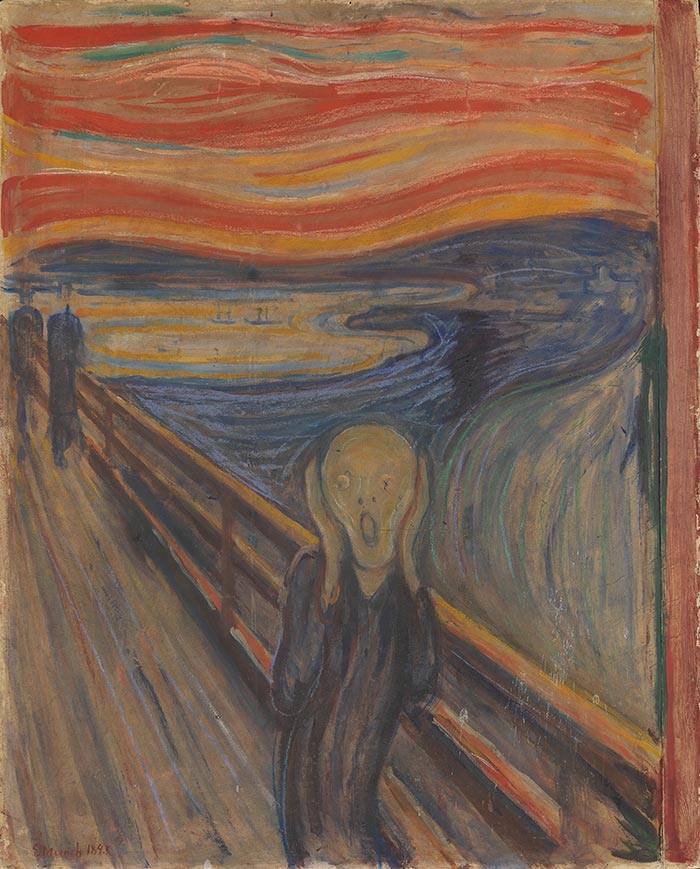
Key Facts
Here are some of the key facts about The Scream:
- The original was painted in 1893 using oil, tempera, and pastel on cardboard. There are four other versions: the pastel version (1893); the lithograph version (1893), the second pastel version (1895) and the tempera version (1910). These are pictured below:




- In 2012, the second pastel version (1895) sold for around $119 million at Sotheby’s Impressionist and Modern Art auction, making it one of the most expensive paintings ever sold (you can see a list of the most expensive paintings ever sold here).
- It was painted during the Symbolism movement. The use of color and distorted forms in the painting also inspired the Expressionism movement.
- The painting is based on a fjord overlooking Oslo. You can see a photo of the location here.
- The painting is commonly known as The Scream, but it also goes by Der Schrei der Natur (The Scream of Nature) in German, or Skrik (The Shriek) in Norwegian.
- Based on historical analysis, Munch used pigments including cadmium yellow, vermilion, ultramarine blue and viridian.
- He wrote about his inspiration for the painting in a note titled Nice 22 January 1892:
“I was walking along the road with two friends – the sun was setting – suddenly the sky turned blood red – I paused, feeling exhausted, and leaned on the fence – there was blood and tongues of fire above the blue-black fjord and the city – my friends walked on, and I stood there trembling with anxiety – and I sensed an infinite scream passing through nature.”
- Munch was tormented by depression, sadness and illness during his lifetime, so The Scream may be an insight into his own state of mind.
For as long as I can remember I have suffered from a deep feeling of anxiety which I have tried to express in my art.” Edvard Munch
- In 1994, the painting was stolen from the National Gallery in Oslo. The theaves left a note which read, “Thanks for the poor security”. The painting ended up being recovered undamaged in 1994. Then in 2004, the 1910 version was stolen from the Munch Museum in Oslo. That painting was also recovered with less-than-expected damage in 2006.
- If you look closely, you will see a chalky, white mark on the right-hand side of the ghoulish figure (pictured below). Research conducted by the University of Antwerp in Belgium suggests this is wax which might have fallen on the painting from burning candles in Munch’s studio (this article has more information on this).

Swirling Lines and Distorted Forms
Munch made use of swirling lines to create a sense of movement, much like Vincent van Gogh did in The Starry Night. Swirling lines were used for the surrounding nature and also the distorted figure. The bridge, the two other figures on the left-hand side and the distant boats in the water are painted with rigid lines and shapes. This may represent a contrast between nature and the civilization being forced upon it.
The two figures on the left-hand side are simple and abstract, but not really distorted like the main figure. This really alienates the main figure, which was painted with elongated hands, a curving body and primitive facial features.

Exaggerated Colors
Munch used color in this painting mostly to convey emotion and drama. He really pushed the colors in the direction of his idea, rather than painting realistically.
There is a powerful contrast between exaggerated reds and oranges used for the sunset in the background, and the dull blues, greens, purples and grays used for everything else.
Munch wrote the following about the painting and the sky, which explains his use of color:
“One evening I was walking along a path, the city was on one side and the fjord below. I felt tired and ill. I stopped and looked out over the fjord-the sun was setting, and the clouds turning blood red. I sensed a scream passing through nature; it seemed to me that I heard the scream. I painted this picture, painted the clouds as actual blood. The color shrieked. This became The Scream.”
The use of color contrast in this painting works two ways: to show the intensity of the “blood red” sunset in the background and the drama of the ghoulish figure on the bridge. Both of these extremes need each other to work effectively in the painting; they complement each other like red complements green.
The ghoulish figure was painted with sickly colors: dull yellows, blues, and purples. Dark and light accents painted over the top hint at the “screaming” expression of the figure. No attention was given by Munch to paint this figure with any sense of realism. It is likely this was a figure of Munch’s own tormented mind.

Whilst the painting appears relatively simple, there is a clever contrast between two pairs of complementary colors: red and green, and orange and blue. This adds a subtle level of complexity and some interesting color relationships to the painting.
The “blood” red in the sky appears to be the strongest color, which contrasts against the very weak green for the land.
The orange is also intense, but it is competing for attention with the blue for the land and water (which is much stronger than the green).

Key Takeaways
- Color can be a powerful tool for depicting drama and emotion. Think about what your big idea is for your painting and try to push your colors in that direction. If you are painting a vivid sunset, then consider making your colors even more warm and intense than they actually are.
- Sometimes, it can be effective to distort the form of your subject in favor of your overall idea, rather than painting the subject realistically.
- Contrast is everything in art. In this painting, Munch relied on contrasting colors, lines, shapes and forms.
- If you want to explore a certain composition further, try using different mediums as Munch did with his pastel, lithograph and tempera versions. You may find that different mediums allow you to capture different aspects or characteristics of a subject.
Additional Readings
A Closer Look at Impression, Sunrise by Claude Monet
A Closer Look at The Starry Night by Vincent van Gogh
What You Can Learn From The Expressionist Art Movement
Want to Learn More?
You might be interested in my Painting Academy course. I’ll walk you through the time-tested fundamentals of painting. It’s perfect for absolute beginner to intermediate painters.
Thanks for Reading!
I appreciate you taking the time to read this post and I hope you found it helpful. Feel free to share it with friends.
Happy painting!
Dan Scott

Draw Paint Academy


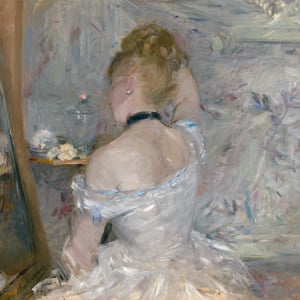
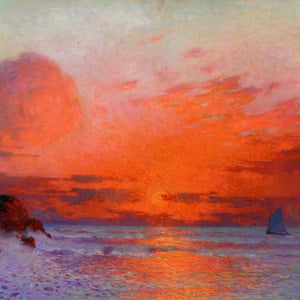
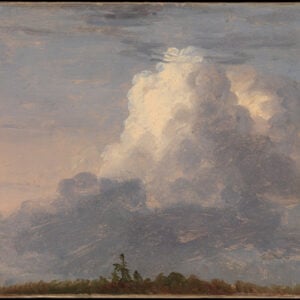
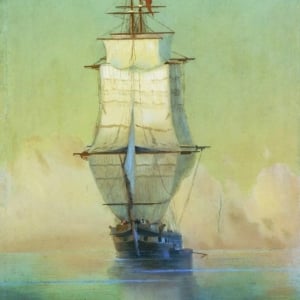

Hello Dan,
I firstly want to say thankyou for all the information, as it was only recently that I pick up a paint brush for the first time, and I’m still loving it.
And secondly, a friend asked if I would paint Edvard Munchs’ – The Scream, I gave it a go, but its definitely not anything remotely worth the original lol.
Thanks again
Wendy Williams
Thanks Wendy! I don’t think the original is remotely worth what it actually is… Dan
I’ve always been negative, yet fascinated by this painting, wondering why it has been so notable. Thank you for bringing attention to all the color contrasts. I actually never saw color because the feeling that is obvious is so overpowering. Does that make sense?
Hello Marian,
I totally agree that we sometimes only notice what most strongly grabs our attention.
I take lots of photos and am amazed at details the camera saw, that I had not noticed.
Recently a giant tree fell across the road and the front of my property. Before long the local volunteer fire brigade arrived. I have no memory of hearing the siren alerting the men to come.
It would have sounded when my neighbour and I were taking her children out the back across boggy paddocks, to a safe place to watch the procedings from.
I love the explanation of the painting. This is helping me so much with my work. Sooo interesting. thank You.
Love this. Have always been curious about this art work, but didnt know much about. Now I do. Thank you, Dan, as always.
Thanks for pointing out that colors do carry emotion in paintings. I know I tend to get lost in the shadows and contrasts!
Don, my opinion will probably not even be acknowledged but l don’t see anything of art-worthiness in this painting(s). This did not require any talent, expertise or skill to make. l classify it along with many others of its ilk as merely a sign of its historical time; an example of rebellion against conformity. lt is only noteworthy for those reasons. lt is a historical artifact, not useful for any of the purposes we make art for.
Thanks Thomas. Interesting thoughts and I tend to agree in part. Some of the paintings I talk about are certainly more for historical significance, rather than a masterful display of our craft (but I do try to stick with the latter). Dan
Thank you for sharing this painting and insight! I look at art so differently now and after reading this even more closely! The colors used, the subject, the emotion!
Thank you again for sharing your insights! I learn so much from your postings!
Dan, I’ve felt like The Scream while struggling with some of my paintings! The timing of this article from you coincided with an acrylic pour done by my niece and she and I agreed it looked much like an Edvard Munch painting. It’s true that art is in the eye of the beholder. I was never a fan of his works, but after your analytical comments, I have an appreciation of his knowledge of color use. Thank you for walking me through his paintings to teach me to look beyond the emotions and find the artistic skills. I appreciated the additional reading references as well.
Hi Dan,
I must say that I empathise with the artist, severe anxiety and depression is no picnic. I would imagine the treatment for it in his day would not have been all that great.
I’m not saying I’m a fan of his art in general, but he certainly nailed what it feels like with that painting and the brush work and colours are pretty darn good.
Thanks for the post, very interesting indeed.
Dave M ???
I appreciate your commentary re The Scream. What constitutes a great work of art is not always easy to articulate. How this has stood the test of time is beyond me!
Thanks, Dan—love your posts.
thanks, for closer observations. I, myself, visited the colors and contours in this painting several times, always intriguing.
Feels like a very bad panic attack..
I really appreciated your research about “The Scream”. I kept telling myself that I should do some research on the painting, but I never seemed to get past the art work of the Impressionists! I do believe that the painting has a social message, but I agree that it is over priced. I think about Picasso in that regard, and whether or not your readers agree with me, I appreciated Picasso’s earlier works and believe that his later works had some social value, but certainly not in the realistic style of painting that a lot of us really appreciate. Please continue your research and commentaries of various artist’s work; it encourages me to think about my own paintings and my messages to the viewer! Thanks so much!
Just like say thank you Dan.
As an ex-pat Norwegian, this was fun to read. I actually enjoy Munch’s work a lot.
Thank you for your insights.